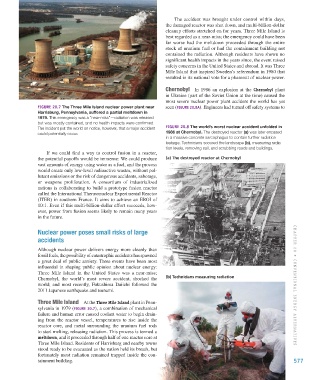Page 578 - Environment: The Science Behind the Stories
P. 578
The accident was brought under control within days,
the damaged reactor was shut down, and multi-billion-dollar
cleanup efforts stretched on for years. Three Mile Island is
best regarded as a near-miss; the emergency could have been
far worse had the meltdown proceeded through the entire
stock of uranium fuel or had the containment building not
contained the radiation. Although residents have shown no
significant health impacts in the years since, the event raised
safety concerns in the United States and abroad. It was Three
Mile Island that inspired Sweden’s referendum in 1980 that
resulted in its national vote for a phaseout of nuclear power.
Chernobyl In 1986 an explosion at the Chernobyl plant
in Ukraine (part of the Soviet Union at the time) caused the
most severe nuclear power plant accident the world has yet
FIGURE 20.7 The Three Mile Island nuclear power plant near seen (FIGURE 20.8A). Engineers had turned off safety systems to
Harrisburg, Pennsylvania, suffered a partial meltdown in
1979. This emergency was a “near-miss”—radiation was released
but was mostly contained, and no health impacts were confirmed.
The incident put the world on notice, however, that a major accident FIGURE 20.8 The world’s worst nuclear accident unfolded in
could potentially occur. 1986 at Chernobyl. The destroyed reactor (a) was later encased
in a massive concrete sarcophagus to contain further radiation
leakage. Technicians scoured the landscape (b), measuring radia-
tion levels, removing soil, and scrubbing roads and buildings.
If we could find a way to control fusion in a reactor,
the potential payoffs would be immense: We could produce (a) The destroyed reactor at Chernobyl
vast amounts of energy using water as a fuel, and the process
would create only low-level radioactive wastes, without pol-
lutant emissions or the risk of dangerous accidents, sabotage,
or weapons proliferation. A consortium of industrialized
nations is collaborating to build a prototype fusion reactor
called the International Thermonuclear Experimental Reactor
(ITER) in southern France. It aims to achieve an EROI of
10:1. Even if this multi-billion-dollar effort succeeds, how-
ever, power from fusion seems likely to remain many years
in the future.
Nuclear power poses small risks of large
accidents
Although nuclear power delivers energy more cleanly than
fossil fuels, the possibility of catastrophic accidents has spawned
a great deal of public anxiety. Three events have been most
influential in shaping public opinion about nuclear energy:
Three Mile Island in the United States was a near-miss;
Chernobyl, the world’s most severe accident, shocked the (b) Technicians measuring radiation
world; and most recently, Fukushima Daiichi followed the CHAPTER 20 • CONVENTI ON AL ENERGY ALTERN ATIVES
2011 Japanese earthquake and tsunami.
Three Mile Island At the Three Mile Island plant in Penn-
sylvania in 1979 (FIGURE 20.7), a combination of mechanical
failure and human error caused coolant water to begin drain-
ing from the reactor vessel, temperatures to rise inside the
reactor core, and metal surrounding the uranium fuel rods
to start melting, releasing radiation. This process is termed a
meltdown, and it proceeded through half of one reactor core at
Three Mile Island. Residents of Harrisburg and nearby towns
stood ready to be evacuated as the nation held its breath, but
fortunately most radiation remained trapped inside the con-
tainment building. 577
M20_WITH7428_05_SE_C20.indd 577 13/12/14 1:56 PM

